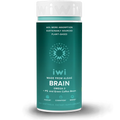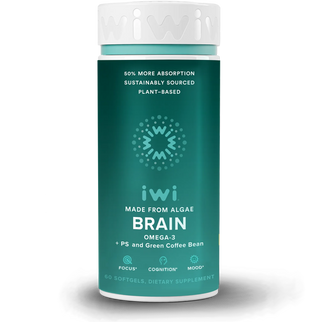Because of this importance, it is vital that we protect our memory. Memory tends to fade with age, but there are things we can do to improve our memory so we can protect it into the later years of life.
Understanding how memory operates is important for learning how to improve it. So today, we’re going to learn about how memory works in the brain and then talk about practical things we can do to support the health of our memory and improve our quality of life. Let’s get started.
What Are the Different Types of Memory?
Before we dive into the parts of our brain, like the cerebral cortex and frontal lobes, that are important for memory, we first need to look at the different types of memory. Then we can get a clearer picture of how to improve it.
Working Memory
When you have an experience or do anything in your life, the first part of your memory that is affected is the working memory. You may have heard this referred to as short-term memory. This is where new memories are formed.
The working memory essentially allows us to remember the information that is relevant to what we’re currently doing. It allows us to stay on task and stay focused on the action we’re performing at any given time.
Essentially, the working memory keeps certain information in place for a short amount of time, allowing the brain to connect that piece of information with other information that is already stored in the brain.
The working memory is also responsible for preparing a memory to be stored in long-term storage. Because of all this, working memory is an incredibly important executive function of the brain.
Explicit Memory
Next, you have your explicit memory (declarative memory), which is one part of what is called long-term memory. There are four types of explicit memory: episodic memory (events), semantic memory (facts), and spatial memory (places). This part of your memory stores information: facts you know, memories of events you experienced, and anything you have to recall consciously is explicit memory.
The explicit memory requires several different parts of the brain. It weaves together multiple brain systems to recall information. It’s an incredibly complex cognitive function. Explicit memory is most likely what you first think of when you think of the word memory.
Implicit Memory
Implicit memory is one of the more interesting aspects of human memory. Implicit memory is also part of long-term memory, but it doesn’t require any conscious effort to retrieve implicit memories.
Implicit memories are subconscious, meaning that they influence our actions without us being entirely aware of it. There are several different types:
- Procedural learning entails subconscious learned actions, such as how to read or walk
- Priming allows you to associate one thing with a similar thing
- Category learning helps you group information together
- Perceptual learning allows you to distinguish things from each other
- Emotional learning helps you understand different emotions you feel and stores them.
The memory system is somewhat built on the framework of implicit memory. Implicit memory almost acts as the foundation of long-term memory by providing the systems your brain needs to store information quickly and effectively without conscious effort.
Which Parts of the Brain Store Memories?

Your memories don’t just all get stored in one place. Synapses are the points of communication between neurons, the cells that make up the brain. Research has established that synapses play an important role in learning and memory. There are different parts of the brain associated with each of the three types of memory. Let’s take a look at each of the regions of the brain to see how these memory processes work.
Prefrontal Cortex
The prefrontal cortex is part of the human brain where working memory is stored. As sensory information comes in, your prefrontal cortex holds it in place, allowing you to focus on it. It then preps that information and ships it off to other parts of the brain to be stored for the long term if the information is deemed to be important enough for memory storage.
Not all information that goes to the prefrontal cortex is stored. For example, you don’t have conscious long-term memories of the colors of shirts people wore as you walked by a crowd on the street. Most sensory information is discarded because it isn’t important to store. In this way, the prefrontal cortex is like the gatekeeper of memory formation.
The left side of the prefrontal cortex works more with verbal working memory, and the right side deals more with spatial working memory.
Hippocampus, Neocortex, and Amygdala
The explicit memory utilizes the function of the hippocampus, neocortex, and amygdala. The hippocampus, situated in the temporal lobe, is where the bulk of our episodic memories are stored. The hippocampus takes the information and projects it to cortical regions.
Scientists discovered this in the 1950s through a patient named Henry Molaison. Molaison had epilepsy, and doctors conducted an experimental surgery that removed his hippocampus to cure his epilepsy. The epilepsy was cured, and he lived for another 55 years. But Molaison essentially lost his ability to form long-term memories.
He could only retain information for a few minutes, and he also was still able to recall the events of his life before the surgery. However, after further study, they discovered that Molaison could still improve his motor skills and learn new ones, definitively showing that implicit memory is stored elsewhere in the brain.
The other brain areas that help with explicit memory are the neocortex and amygdala. The neocortex holds some general knowledge, and information transfers there as we sleep. The amygdala is responsible for assigning emotions to memories, memory consolidation, and determining a memory’s importance.
Basal Ganglia and Cerebellum
The basal ganglia and cerebellum are responsible for implicit memory. The basal ganglia are responsible for more general motor skills, the formation of habits, and the processes of learning. The cerebellum is responsible for fine motor skills.
What Can I Do To Support My Memory?

The whole point of understanding how memory works and where it is stored is so that we can get a better grasp on how we can bolster it. So let’s talk about practical things you can do to support and improve your memory.
Stay Active
One of the most important things you can do to support your memory as you age is to stay physically active. Exercise supports far more than just your heart health. It supports your health as a whole.
In fact, physical activity actually increases the size of the hippocampus, which is where your episodic (events) memory is stored. By bolstering this section of your brain, you can help it retain those precious memories that you hold dear.
Get Quality Sleep
Getting enough sleep is vital for supporting your brain health and your memory. Most neuroscientists believe that most of your long-term memories are transferred from the hippocampus to the neocortex during sleep.
Remember, the neocortex stores general information and facts, so if you want to help your brain remember more facts as you age, getting enough sleep can help that information have a safe transfer.
Maintain a Social Life
Social interaction is incredibly important for the health of your brain. Not only does connecting with friends and loved ones feel great, social interactions are like a workout for your brain. You’re taking sensory input, mixing it with emotions, utilizing your memories about facts and events, strengthening your short-term memory, and using your motor skills with your mouth and gestures.
It utilizes so many of the different brain structures and systems, so it’s a great way to keep your brain active and strong.
Support Brain Health With Omega-3s
You can also support the health of your brain by getting proper nutrition. One of the most important nutrients to support brain health are omega-3 fatty acids. Omega-3s like EPA and DHA are important in maintaining the structural integrity of the cell membranes in your brain cells.
Getting enough omega-3s can work to support the health of your neurons and synapses so that they can remain healthy. They’re used in all different areas of the brain, and they can help support your brain health as a whole, even as you age.
DHA, in particular, may help reduce certain markers of inflammation. It’s another layer of protection for your brain. Supporting the health of your brain in this way can also support your memory in the long run — and iwi life can help! Our plant-based omega-3 Supplements are a great way to maintain your memory with essential healthy fats.
Quality Memory for Years To Come
Memory is such an interesting and important aspect of neuroscience, and it’s one of the most valuable parts of being human. The facts we know, the experiences we’ve lived, and the skills we know all live in our memory, so it’s important to protect them.
Now you know the steps you can take to support a healthy brain to protect and cherish the memories you hold dear. You can support your memory with physical activity, quality sleep, regular social interaction, and our Brain Supplements here at iwi life.
Sources
Here's how to improve your everyday memory as you age | University of Kentucky Healthcare
Implicit and Explicit Memory | Simply Psychology
Health benefits of docosahexaenoic acid (DHA)
Where are memories stored in the brain? | University of Queensland



















